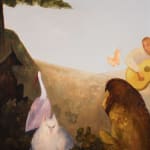

Constant Dutch, 1920-2005
41 3/8 x 39 3/8 inches
In 1969, after fifteen years of working on his visionary New Babylon project, Constant returns to painting. Initially they are still strong elements of New Babylon but gradually his subject matter changes. As before, Constant is inspired by socially critical and political subjects, such as the war in Vietnam, famine in Africa and the refugees from Kosovo, but slowly more classical motifs creep into his work (such as Orpheus and the Marquis de Sade).
In the tradition of the Venetian Renaissance painters, Titian and Tintoretto, Constant focuses on the technique of colourism. In this technique, the artist does not use charcoal or pencil sketches, but applies the oil paint directly to the canvas with the brush, creating soft transitions instead of sharp contours. The main feature of this technique is the way light is represented in the painting, by integrating it into the colour. The painting comes to life layer by layer, sometimes up to ten layers of paint.
Constant paints with oil on canvas and each layer he applies has to dry before he can continue working. It is a laborious technique and, in this period, he makes no more than three to four oil paintings a year.
Orpheus
The Greek Mythological figure Orpheus was a legendary musician, poet, and prophet who could charm not only all living beings with his music, but also stones and trees. This ability to do so combines two of Constant’s major loves in life: music and animals.
Orpheus was an important theme in Constant’s work between 1981 and 2000. It was the subject for three major oil paintings (of which this painting is the first) and for a number of watercolours, drawings and prints. Constant transformed Orpheus I into an etching that was part of a portfolio with graphic works from twenty contemporary artists. This portfolio was published by GIN gallery and printed by Studio Art 3 in Milan, Italy.
Orpheus II (1983, 79 x 81 cm) is in the de Heus- Zomer collection, The Netherlands.
Orpheus III (1988, 126 x 130 cm) belongs to the Fondation Constant, on long term loan to the Stedelijk Museum, Schiedam.
Provenance
Bought directly from the artist by Dr. R. Gielen, Voorschoten, circa 1982
Thence by descent to the previous owners
Exhibitions
1985, Constant |. Werk uit de periode 1975-1985, Centraal Museum, Utrecht
1986, Constant: 1945 - 1983, Rheinisches Landesmuseum, Bonn
Literature
Honnef, Klaus, Constant: 1945 - 1983, exh.cat. Bonn (Rheinisches Landesmuseum) 1986 (ill.)
Lambert, Jean-Clarence, Constant. Les trois espaces, Éditions Cercle d'Art (Paris) 1992, p. 143 (ill.)


